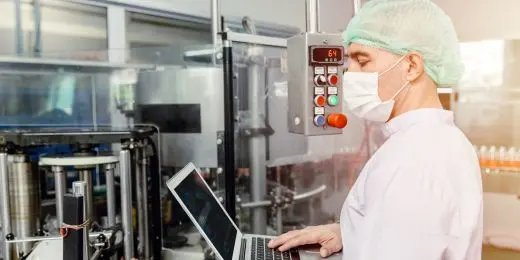What is Food Hygiene?
As an important part of food safety and ensuring the health and well-being of consumers, food hygiene is the practice of handling, preparing, and storing food in a way that prevents foodborne illnesses. Also, it’s a set of guidelines designed to keep food safe from contamination and spoilage.
Everyone involved in the food industry must understand and practice food hygiene and adhere to strict food safety regulations. The practice of food hygiene involves the use of proper sanitation and cleaning practices, as well as the use of Personal Protective Equipment (PPE).
Who is Responsible for It?
Everyone in the food chain has a responsibility to ensure that food is safe and free from contamination. This includes food producers, processors, distributors, retailers, caterers, and consumers.
Food hygiene is especially important for those who work in the food industry, such as chefs, cooks, and food handlers. They must be aware of the risks associated with food contamination and take steps to prevent it. This practice is also important for those who work in food-related businesses, such as restaurants, cafeterias, and grocery stores. These businesses must ensure that their employees are properly trained in food safety and hygiene practices and that their premises are kept clean and free from hazards. They must also ensure that their food is stored and handled correctly to avoid contamination.
What is the Difference Between Food Hygiene and Food Safety?
Food safety refers to a wide range of practices and aspects that food businesses apply as part of their Food Safety Management System (FSMS). One aspect of it is food hygiene, which focuses on implementing food safety measures while maintaining cleanliness and orderliness in the workplace as workers deal with food products.
Further, food hygiene aims to:
- provide education and training on proper and safe food handling for the people involved in food processing, preparation, and manufacturing;
- maintain and extend food shelf life through clean processing;
- prevent food spoilage due to contamination caused by unhygienic working practices and workplace conditions; and
- avoid producing and selling unsafe food that may threaten public health.
Why is Food Hygiene Important?
The Centers for Disease Control and Prevention (CDC) estimates that 1.35 million illnesses, 26,500 hospitalizations, and 420 deaths in the United States yearly are caused by Salmonella. Salmonella infections are commonly contracted by eating raw food or undercooked meat, which are possibly due to unhygienic food preparation, unsafe food handling, or cross-contamination.
Hence, the practice of food hygiene not only helps businesses improve the quality of their products and services but also ensures people are safe when buying and consuming food. Apart from those, the following are the various benefits of implementing and maintaining food hygiene best practices:
Mitigate the Risk of Foodborne Illnesses
Food handlers who practice proper food hygiene can reduce the risk of foodborne illnesses, which can be caused by bacteria, viruses, and parasites. Also, safe and hygienic preparation of food is key to reducing the risk of food spoilage and lessening food waste.
Protect Business Reputation
Food businesses can demonstrate to their customers that they are taking the necessary steps to ensure the safety of their food. This can foster and maintain customer trust and loyalty, leading to increased sales and profits.
Reduce Environmental Impact
Food hygiene also plays a key role in helping businesses become eco-friendly in various ways. This includes reducing the amount of food waste that is produced, as well as the amount of energy and water used in the preparation and production of food.
Types
There are several different types of food hygiene that must be followed in order to ensure the safety of food. Some of these include the following:
Personal Hygiene
This includes washing hands before and after handling food, wearing clean clothes and hairnets, and avoiding contact with food if you have any open wounds or cuts. It’s also important to keep food preparation areas clean and free from pests.
Food Storage
This type involves storing food at the correct temperature, using separate containers for raw and cooked food, and ensuring that food is not left out of the refrigerator for too long. It is also essential to label food with the date it was prepared and discard any food that has been left out for too long.
Food Preparation Hygiene
This includes washing all fruits and vegetables before use, cooking food to the correct temperature, and avoiding cross-contamination between raw and cooked food. It is also important to use clean utensils and surfaces when preparing food.
Risks of Not Practicing Food Hygiene
Food Contamination and Poisoning
Not following proper food hygiene practices can lead to food contamination. This can cause food poisoning, foodborne illnesses such as Salmonella and E. coli infections, and a range of symptoms, from mild stomach upset to severe dehydration and even death.
Quick Food Spoilage
Not following food hygiene practices can also lead to the growth of bacteria and other microorganisms in food. This can cause food to spoil quickly, leading to food waste and financial losses.
Spread of Pests
Pests such as rodents and insects can contaminate food and spread diseases, as well as cause damage to food storage areas and equipment. In addition, pests can also spread allergens, which can cause serious health problems.
Regulations
Regulations are designed to protect consumers from food hygiene-related risks and other health hazards associated with improper and unhygienic preparation and production of food. In most countries, food hygiene laws and regulations are set by the government and enforced by local health authorities. Some examples include the following:
- United States
- Food Safety and Inspection Service (FSIS) of the US Department of Agriculture (USDA)
- US Food and Drug Administration (FDA)
- Centers for Disease Control and Prevention (CDC)
- United Kingdom
- Food Standards Agency (FSA)
- Food Hygiene Regulations 2006
- Food Safety and Hygiene (England) Regulations 2013
- Food Hygiene (Wales) Regulations 2006
- Food Hygiene (Scotland) Regulations 2006
- Australia
- Food Standards Australia New Zealand (FSANZ)
Food hygiene regulations usually require food businesses to maintain certain standards of cleanliness and sanitation. This includes regular cleaning and disinfection of food preparation areas, equipment, and utensils.
Also, regulations require food establishments to keep records of their food safety practices. This includes records of food safety and hygiene inspections, food safety training, and any corrective actions taken in response to food safety issues. These records must be kept up-to-date and readily available for inspection by health authorities.
Training
Food hygiene training can be provided in a variety of ways, including online courses, classroom-based courses, and on-the-job training.
Online Courses
Online or mobile-first courses are a great way to learn about food hygiene, as they are often self-paced and can be completed at any time. They are also often more cost-effective than classroom-based courses. However, online courses may not be suitable for everyone as they may not provide the same level of interaction and support as classroom-based courses.
Classroom-based Courses
Classroom-based courses are a great way to train employees about food hygiene as they provide a more interactive learning environment. They also provide the opportunity to ask questions and receive feedback from an experienced instructor. However, classroom-based courses can be more expensive and may require more time to complete.
On-the-job Training
On-the-job training is another good option for learning about food hygiene. This type of training is often provided by employers and can be tailored to the specific needs of the food handler. On-the-job training is often the most cost-effective and time-efficient way to learn about food hygiene.
Audits
Food hygiene audits are conducted by a third-party auditor who assesses the food safety practices of a business. The auditor will look at the FSMS, the food safety policies, procedures, and practices of the business. They will also check the food safety records and training of the staff. The audit will provide a detailed report of the findings and any areas that need improvement.
Food hygiene audits are conducted on a regular basis to ensure that food safety standards are being met. The frequency of the audits will depend on the type of business and the level of risk associated with the food being served. The auditor will also look at the food safety records to ensure that the business is following food safety regulations. They will provide an independent assessment of the food safety practices of a business and help identify any areas for continuous improvement. The audit report will give the business a detailed overview of the food safety practices and any areas that need to be addressed.
In conducting audits, using a checklist to help standardize the process is a must. A checklist template is effective in ensuring that all aspects of your organization’s food hygiene and safety practices are being properly followed and implemented.
To help you in creating a food hygiene audit checklist, here are some templates you can download and customize from SafetyCulture (formerly iAuditor)’s Public Library:
- Food Hygiene Audit Template
- Daily Food Hygiene Checks
- Food Safety & Hygiene Inspection Checklist – Kitchen
- Daycare Food Hygiene Inspection
Create Your Own Food Hygiene Audit Checklist
Eliminate manual tasks and streamline your operations.
Get started for FREECertification
Food hygiene certification is a process that involves verifying that a food business has met the necessary standards for food safety and hygiene. Certification is typically done by a third-party organization accredited by a government agency. The certification process typically involves an audit of the food business’s overall processes and a review of its food hygiene policies and procedures.
It also helps ensure that food businesses are taking the necessary steps to prevent foodborne illnesses. It’s crucial for food businesses to obtain certification in order to demonstrate that they are taking the necessary steps to protect public health and ensure safe food consumption.
FAQs About Food Hygiene
Those working in the food industry must practice the 4 Cs of food hygiene. This way, they can avoid the dangerous risks associated with unsafe methods of food handling, processing, and production. The 4 Cs are:
- Cross-contamination
- Cleaning
- Cooking
- Chilling
In general, local health authorities are the ones responsible for enforcing food hygiene and safety regulations and laws. They mainly follow the guidelines set out by the US FDA. Those in other countries and regions can refer to their national or other relevant governing agencies for proper enforcement.
In the US, states have dedicated channels or websites where consumers can report food hygiene and safety complaints or concerns. You may also refer to this collection of State or Territorial Health Department websites from the CDC to check those relevant to where you are.
Food hygiene rating is a scoring system mainly used in the UK but also utilized globally to rate food hygiene standards and practices of food businesses. The food hygiene rating scheme commonly uses a scale of 0 to 5, with 0 being the lowest and 5 being the highest.
Businesses can streamline their inspections and audits using food hygiene rating checklists.




